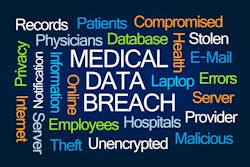At the California Healthcare Innovation Conference, a Sobering Discussion Around Cyber Threats
At the California Healthcare Innovation Conference, being sponsored by Healthcare Innovation and taking place this week at the Sofitel Hotel Los Angeles at Beverly Hills, cybersecurity experts engaged in a sobering discussion on Wednesday, Nov. 2, of the intensifying cybersecurity threats confronting patient care organizations across the U.S. healthcare system.
Healthcare Innovation Managing Editor Janette Wider moderated the discussion, whose panelists were Elliott Jones, CISO at Keck Medicine of USC in Los Angeles, and Richard Stayings, chief security officer at the New York City-based Cylera, and a professor at the University of Denver, under the heading, “Cybersecurity: Biggest Threats, Biggest Opportunities.” Below are a few excerpts from the extensive discussion.
Wider noted that “The landscape of cybersecurity isn’t great; the bad actors are getting ‘badder,’ so to speak, and CIOs and CISOs have more to worry about than ever. So how should organizations begin to prepare?” she asked the panelists.
“The U.S. is by far the biggest victim of cyber attacks against healthcare,” Staynings noted. There are between two and three hospitals every week being attacked by ransomware; that’s pretty alarming. A lot of those incidents aren’t publicly reported. But it’s a trend that’s getting worse, not better. As Oscar [Miranda, field CTO at Armis] noted this morning, healthcare is a lucrative target; and it’s compounded by the fact that we don’t have adequate security in place, and therefore are an easier target. Indeed, the fact that organizations are paying ransoms, is fueling that attack work.”
“And the nature of the attacking organizations is that they’re becoming more sophisticated,” Jones emphasized. “And having to invest in security to a high level is very challenging. Sophos [in its “The State of Ransomeware 2022” report] found that 66 percent of responding organizations in 2021 were directly affected.
“Two-thirds of U.S. residents have had their identity stolen in some way, at this point,” a huge percentage, Staynings noted.
“How are you preparing at USC?” Wider asked. “Obviously, you’re focusing on prevention; but that’s only half of the story,” Jones replied. “When it does happen, how do you respond? And so requires looking at how to respond. We’re seeing organizations being impacted up to the point of being down for one month. Imagine one month of working with pen and paper. It’s devastating. So it’s really about coming up with good strategies and testing those strategies with live tests, regularly.”
“And what is the impact on patient mortality, morbidity, etc.? It can be $129 million in lost revenue. Yet we take the risk and roll the decide and bet that it won’t happen on our watch, yet it will,” Staynings said.
“Let’s talk about segmentation,” Wider said. “Elliott, what are your thoughts on segmenting medical devices?”
“When we’re talking about segmentation, we’re really talking about isolating devices, such as IoT [Internet of Things] devices, and placing them into a container, if you will,” Jones said. “Historically, that’s what my peers have done. But what we’ve come to find out is that that’s only half of what you need; you need a comprehensive program in order to address devices. Look at your device inventory, your vulnerability plans, and how you’ll recover. So you have to look at this more holistically. There’s also the component of the volume of devices involved. There was a great publication by IoT Analytics; they report annually, and found in 2021 that the increase in IoT globally was 18 percent; and they’re anticipating a 22-percent Y0Y growth in IoT. At USC, we’re on pace to have more IoT devices than classic IT devices. If the IoT devices compromise more than half of my inventory, it’s no longer a segment; it’s my environment; so it requires building a comprehensive program.”
“You need to understand those devices,” Staynings stressed. “What about devices that cannot be patched because the manufacturers have been lax in publishing patches. There are devices older than 15 years old that cannot be patched, and manufacturers who refuse to patch, and who hopefully will be out of business soon. But you need to understand the threat levels involved, and need to be able to automate and orchestrate, around your network access control. The tolls are there for you to use; it’s a question of automating that process. And you need not just macro segments, such as for devices in general, but micro-segmentation. Say, all my Hospira pumps are at risk, because, say, the Chinese, Iranians and North Koreans are attacking these devices to upload software for ransomware attacks or other reasons. So I need to isolate the Hospira pumps in order to not impact the HIT systems.”
“I once interviewed someone who said it would be as though you moved into your house and never cleaned up and just threw everything on the floor and then tried to clean up,” Wider offered. And then she asked her panelists, “What about cloud security? What should we understand there?”
“The idea of being able to take on that old-school approach to security where you build your castle walls and your moat—those days are over,” Jones stated. “Data proliferation is now the norm; we’re using Azure, Google, now Vertica; name your flavor of cloud, and you’re using it; and it may be through a SAS [software as a solution] solution. So it really speaks to looking at a cloud strategy, and a procurement strategy, that incorporates security. You need to ensure that at a contractual level. And when you look at a third party that might have access to your data, you have to look at issues like contractual issues. We’re seeing much lower limits on cybersecurity insurance, which means we have to transfer a lot of that risk to our third-party vendor partners. So you need to develop a strategy.”
“In fact,” Staynings said, “It’s a hybrid multi-cloud strategy that most hospitals are in right now, so you’ve got multiple clouds with multiple sets of data, so you need to know what you have; and many vendors contract with liability limits. So you have to train people on the cloud for nuances, and make sure they’re brought up to speed. There’s also a bigger question here: breach insurance will become unaffordable in the next three years. No one’s going to be able to spend sufficient money. So you need to spend your money on cybersecurity, because you’re going to get hit. Because the insurance companies are including in their contract language that they won’t pay for incidents of war, and we’re in a war now with national government actors. And an insurance company might say, you didn’t have effective security protocols in place, such as monthly training, or effective control management, or micro-segmentation, or risk remediation; therefore, the $300 million we were going to pay for, we’ll pay for only $50 million, and good luck on the rest.”
“I agree with Richard; you can’t rely on insurance,” Jones said. “And what is the value of reputation? And what is the value of a life? And so I think really, what we’re looking at is a change, at least in our organization, is a change in how we’re doing things. Years ago, we were taught that security is like a pyramid, and the foundational element is physical security, then network security, than application layer, and the top of the pyramid is data security. And now we’ve flipped that equation and are saying that data security really is the foundation. Data governance. It goes back to that segmentation conversation; you can apply controls to achieve outcomes.”
“Not everyone works in the IT department; and cybersecurity is becoming a cultural issue in an organization,” Wider underscored. “My husband is an engineer and works for a multinational company; he used to work for a mom-and-pop organization where they were working on Windows 7 and such; now, he has to be regularly trained on IT security, and is taking regular phishing tests. So in healthcare, how are you getting it to work?”
“The time of our physicians and nurses is so valuable,” Jones noted. “And a lot of it involves trying to change culture, which is probably the hardest part of this job. Technology, we can employ in days or weeks, but cultural change takes years. So we’re looking at things like game-ification in security training; I know that sounds impossible, but it’s possible. And working with your HR and marketing departments in order to construct training that’s actually fun for people. As IT folks, we tend to be pretty dry; we need to rely on people who can help us with that. And look at physicians: they’re constantly being tempted to click on something or install something. Organizations are striving towards 3 to 5 percent as the industry standard of what’s good. And you should be able to achieve that over time. We found that once we had changed our approach and incorporated things like applications our people actually use, all of a sudden, our numbers went down to high double digits. So you have to look at your curriculum, because a sophisticated threat actor is going to send sophisticated emails that look very real. In addition, there’s now voice phishing. Are you doing phone calls, SMS phishing tests? We’ve done NFA [National Futures Association] tests, and the results have been surprisingly bad. So it’s really about creating a training program that accomplishes all aspects of that, to guarantee the biggest success.”
“It must be integral rather than a one-off,” Staynings emphasized. “We need to train our nurses in nursing school about privacy and security; we train them about some of the HIPAA security rules, but don’t really train them about modern cybersecurity issues. The same is true about med school; we need to train our doctors. New doctors are placed into the situation; and there was a situation a few years ago in which, at the RSA conference, a group of ER physicians were tested on security onstage. It needs to be an integral approach to cybersecurity, and it needs to start at the board of directors and move on down. It can’t be just an annual little test; it needs to be multimedia, game-ified, and ongoing.”
“And it needs to become cultural, and part of everything you do,” Jones affirmed.
OCR Bulletin: Obligations under HIPAA for Online Tracking Technologies
The Office for Civil Rights at HHS issued a bulletin on Dec. 1 addressing tracking technologies, like Google Analytics or Meta Pixel, that may violate HIPPA Rules
By Janette Wider
On Dec. 1, the Office for Civil Rights (OCR) at the U.S. Department of Health and Human Services announced via a press release that it has issued a bulletin to detail the requirements of Health Insurance Portability and Accountability Act of 1996 (HIPAA) on covered entities and business associates (“regulated entities”) under the HIPAA Privacy, Security, and Breach Notification Rules (“HIPAA Rules”) when using online tracking technologies. The tracking technologies—such as Google Analytics or Meta Pixel—are meant to analyze information about how users are interacting with a regulated entity’s website or mobile application.
The press release states that “Some regulated entities regularly share electronic protected health information (ePHI) with online tracking technology vendors and some may be doing so in a manner that violates the HIPAA Rules. The HIPAA Rules apply when the information that regulated entities collect through tracking technologies or disclose to tracking technology vendors includes ePHI. Regulated entities are not permitted to use tracking technologies in a manner that would result in impermissible disclosures of ePHI to tracking technology vendors or any other violations of the HIPAA Rules.”
“Today’s bulletin addresses potential impermissible disclosures of ePHI by HIPAA regulated entities to online technology tracking vendors,” the release adds. “The Bulletin explains what tracking technologies are, how they are used, and what steps regulated entities must take to protect ePHI when using tracking technologies to comply with the HIPAA Rules.”
The bulletin will highlight examples of:
- Tracking on webpages
- Tracking within mobile apps
- HIPAA compliance obligations for regulated entities when using tracking technologies
OCR director Melanie Fontes Rainer was quoted in the release saying that “Providers, health plans, and HIPAA-regulated entities, including technology platforms, must follow the law. This means considering the risks to patients’ health information when using tracking technologies. Our Bulletin answers questions for those using tracking technologies, importantly how to protect the privacy and security of the health information they hold.”
The bulletin can be accessed at: https://www.hhs.gov/hipaa/for-professionals/privacy/guidance/hipaa-online-tracking/index.html.
HHS encourages those who believe their or another individual’s health information privacy or civil rights have been violated to file a complaint here: https://www.hhs.gov/ocr/complaints/index.html.
HC3 Analyst Note: LockBit 3.0
The Health Sector Cybersecurity Coordination Center issued an analyst note on Dec. 12 regarding LockBit 3.0 ransomware as a threat to the healthcare and public health sector
By Janette Wider
On Dec. 12, the Health Sector Cybersecurity Coordination Center (HC3) issued an analyst note on LockBit 3.0 ransomware. LockBit 3.0 is the newest version of the LockBit ransomware that was first discovered in September of 2019.
The note says that “The ransomware family has a history of using the Ransomware-as-a-service (RaaS) model and typically targets organizations that could pay higher ransoms. Historically, this ransomware employs a double extortion technique where sensitive data is encrypted and exfiltrated. The actor requests payment to decrypt data and threatens to leak the sensitive data if the payment is not made. With the new release, it appears that the ransomware is using a triple extortion model where the affected victim may also be asked to purchase their sensitive information. Since its appearance, HC3 is aware of LockBit 3.0 attacks against the Healthcare and Public Healthcare (HPH) sector. Due to the historical nature of ransomware victimizing the healthcare community, LockBit 3.0 should be considered a threat to the HPH sector.”
LockBit 3.0, also dubbed LockBit Black, was discovered in June of this year. The gang operates with the RaaS model along with affiliates who don’t have the resources of their own to create and deploy attacks. A percentage of the ransom goes to the affiliate hacker. Ransom numbers have been seen into the millions of dollars (USD) range. Additionally, LockBit 3.0 has been a particular challenge for security researchers, as the malware sometimes requires a 32-character password each time it is launched, giving it anti-analysis features.
The note adds that “Research from Sophos suggests that the ransomware has carried over most of the functions from LockBit 2.0 but has been observed to have new capabilities. Also, the malware appears to be utilizing features of another well-known ransomware, BlackMatter. These similarities include the ability to send ransom notes to a printer on the network, deleting Volume Shadow Copies, obtaining the victim’s operating system, and several debugging features. LockBit 3.0 will take additional steps to attempt to obfuscate itself. Due to the striking number of similarities, Sophos suggest that LockBit 3.0 could be reusing some of the code from BlackMatter.”
That said, “Further research states that LockBit 3.0 is a Win32.exe file, and uses the “-pass” argument for execution. The encryption uses a Base64-encoded hash and an RSA public key in its configuration and hashes it with MD5. The malware is capable of targeting Windows and Linux systems. Additionally, the new strain contains worm capabilities to spread itself without human interaction. Encrypted files can only be unlocked with LockBit’s decryption tool. Once on the network, the ransomware attempts to download command and control (C2) tools such as Cobalt Strike, Metasploit, and Mimikatz.”
An analyst comments in the note that “LockBit 3.0 is the newest strain of the LockBit ransomware which appeared in June 2022. After a leak on Twitter, the builder has been used by other threat attackers like the Bl00dy ransomware gang. Additionally, LockBit has unveiled their own bug bounty program for reporting vulnerabilities which is open to both ethical and unethical hackers. LockBit has been seen to target multiple organizations globally but has heavily victimized the United States and HPH sector. On previous compromises in the HPH sector, the threat actor has occasionally shared proof via screenshots that the network has been compromised and will threaten to publish the stolen data after a set timeline.
Other techniques HC3 sees following attack vectors associated with ransomware include:
- Phishing
- Remote Desktop Protocol (RDP) compromises and credential abuse
- Compromises of exploited vulnerabilities, like VPN servers
- Compromises in other known vulnerabilities


